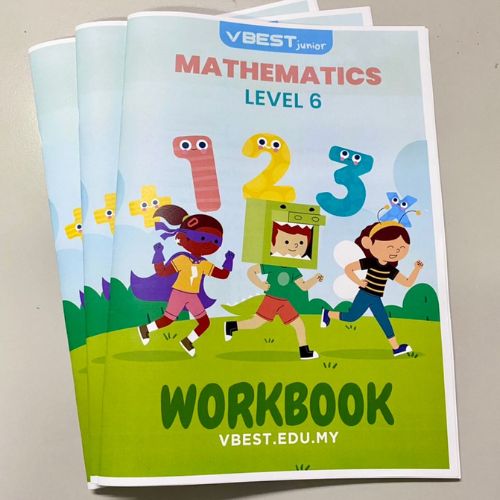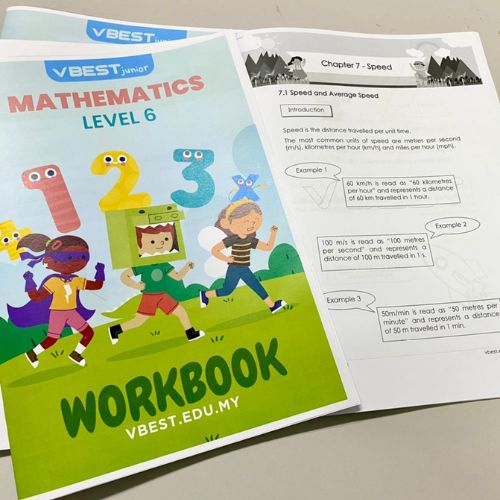
VBest International Primary Maths program offers classes for children between the ages of 3 to 13 years old.
Our program assists students in staying ahead of their peers in primary school.
Maths Workbook



Course Details
Suitable for 4 years old kids.
- Phonics Song ( Numbers 1 to 30 - Sound Associations )
- Singing Numbers Song ( 1 to 30 )
- Flash Card Learning ( Numbers, Addition & Subtraction )
- Reading and Writing Ordinal Numbers ( Numbers 1 to 30 )
- Reading and Writing Cardinal Numbers ( Numbers 1 to 30 )
- Exploring Odd Numbers ( Numbers 1 to 30 )
- Exploring Even Numbers ( Numbers 1 to 30 )
- Comparing Groups Of Numbers ( Numbers 1 to 30 )
- Counting Up To 30 ( Including Skip Counting )
- Measurement ( Length )
- Simple Math ( Addition & Subtraction )
- Math Practice Games ( Pancake Flip Phonics Style )
Suitable for 5 years old kids.
- Phonics Song ( Numbers 30 to 60 - Sound Associations )
- Singing Numbers Song ( 30 to 60 )
- Flash Card Learning ( Numbers, Addition, Subtraction & Multiplication )
- Reading and Writing Ordinal Numbers ( Numbers 30 to 60 )
- Reading and Writing Cardinal Numbers ( Numbers 30 to 60 )
- Exploring Odd Numbers ( Numbers 30 to 60 )
- Exploring Even Numbers ( Numbers 30 to 60 )
- Comparing Groups Of Numbers ( Numbers 30 to 60 )
- Counting Up To 60 ( Including Skip Counting & Counting Backwards )
- Measurement ( Length & Weight )
- Simple Math ( Addition, Subtraction & Multiplication )
- Math Practice Games ( Playing Cards Math )
Suitable for 6 years old kids.
- Phonics Song ( Numbers 60 to 100 - Sound Associations )
- Singing Numbers Song ( 60 to 100 )
- Flash Card Learning ( Numbers, Addition, Subtraction, Multiplication & Division )
- Reading and Writing Ordinal Numbers ( Numbers 60 to 100 )
- Reading and Writing Cardinal Numbers ( Numbers 60 to 100 )
- Exploring Odd Numbers ( Numbers 60 to 100 )
- Exploring Even Numbers ( Numbers 60 to 100 )
- Comparing Groups Of Numbers ( Numbers 60 to 100 )
- Counting Up To 100 ( Including Skip Counting, Counting Backwards & Missing Numbers )
- Measurement ( Length, Weight & Capacity )
- Money
- Graphing
- Simple Math ( Addition, Subtraction, Multiplication & Division )
- Math Practice Games ( Board Games that Involve Counting: Candy Land, Chutes & Ladders, Trouble, Monopoly )
Chapter 1 Number & Place Number
1.1 Arranging Numbers in Ascending Order
1.2 Arranging Numbers in Descending Order
1.3 Number Words
1.4 Place Value
Chapter 2 Addition & Subtraction
2.1 Addition
2.2 Subtraction
Chapter 3: Fractions
3.1 Quarters Of Amounts
3.2 Recognizing Halves
3.3 Recognizing Quarters
Chapter 4 Measurement
4.1 Measuring Mass
4.2 Measuring Capacity & Volume
4.3 Measuring Length & Height
Chapter 5 Money
5.1 Addition Of Money
5.2 Subtraction Of Money
Chapter 6 Multiplication & Division
6.1 Multiplication
6.2 Division
Chapter 7 Position & Direction
7.1 Position & Direction
7.1 Identifying Places
Chapter 8 Time
8.1 Measuring Time
Chapter 9 Shape
9.1 2D Shape
Chapter 1 2D And 3D Shapes
1.1 Introduction
1.2 Line Symmetry
1.3 Naming Shapes
1.4 Placing Shapes in order
1.5 2D Shapes On Common 3D Objects
1.6 Spot 2D Shapes On 3D Solids
1.7 Position And Direction
Chapter 2 Number Sequences
2.1 Ascending Order
2.2 Descending order
2.3 Comparing And Ordering
2.4 Comparing And Sorting
Chapter 3 Addition
3.1 Adding Tens
3.2 Complete The Addition Table
3.3 Adding Two Numbers
Chapter 4 Subtraction
4.1 Subtraction
4.2 Complete The Subtraction Table
4.3 Subtracting Two Numbers
Chapter 5 Fraction
5.1 Recognize Fractions
5.2 Fractions Of Numbers
5.3 Addition Of Fractions
5.4 Subtraction Of Fractions
Chapter 6 Measurement
6.1 Comparing Lengths And Masses
6.2 Measuring Capacity And Volume
Chapter 7 Money
7.1 Addition Of Money
7.2 Subtraction Of Money
Chapter 8 Place Values
8.1 Ten And Units
Chapter 9 Data
9.1 Comparing Data
9.2 Counting And Sorting Data
9.3 Statistics
Chapter 10 Time
10.1 Measuring Time
10.2 Counting Minutes
10.3 Counting Hours
Chapter 11 Multiplication & Division
11.1 Multiplication
11.2 Division
Chapter 1 Shapes
1.1 Know Your 2D Shapes-Count the Shapes
1.2 Know Your 2D Shapes-How Many Sides
1.3 Level T-Know Your 2D Shapes ~ Introducing Shapes
1.4 Level T-Know Your 2D Shapes ~ Using Tree Diagrams
1.5 Level T-Know Your 2D Shapes ~ What Can You See
1.6-2D and3D Shapes
1.7-2D and 3D Shapes
Chapter 2 Addition
2.1 Addition
2.2 Addition 1
2.3 Addition 2
Chapter 3 Counting
3.1 Counting 1
3.2 Counting 2
Chapter 4 Division
4.1 Division 1
4.2 Division 2
Chapter 5 Four Operation
5.1 Four Operation 1
5.2 Four Operation 2
Chapter 6 Fractions
6.1 Fractions 1
6.2 Fractions 2
Chapter 7 Graphs, Charts, and Tables
7.1 Graphs, Charts, and Tables 1
7.2 Graphs, Charts, and Tables 2
Chapter 8 Lines, Angles and Degree
8.1 Lines, Angles and Degree 1
8.2 Lines, Angles and Degree 2
Chapter 9 Measurement
9.1 Measurement 1
9.2 Measurement 2
Chapter 10 Money
10.1 Money 1
10.2 Money 2
Chapter 11 Multiplication
11.1 Multiplication 1
11.2 Multiplication 2
Chapter 12 Multiplication and Division
12.1 Multiplication and Division 1
12.2 Multiplication and Division 2
Chapter 13 Number Words
13.1 Number Words 1
13.2 Number Words 2
Chapter 14 Place Value
14.1 Place Value 1
14.2 Place Value 2
Chapter 15 Statistics
15.1 Statistics 1
15.2 Statistics 2
Chapter 16 Subtraction
16.1 Subtraction 1
16.2 Subtraction 2
Chapter 17 Time
17.1 Time 1
17.2 Time 2
Chapter 1 Number Sense
1.1 Place Value, standard and Expended Form
1.2 Prime, Composite Number and Rounding
1.3 Roman Numerals
1.4 Odd and Even Numbers
1.5 Inequalities and Compare Higher and Lower Numbers
Chapter 2 Addition
2.1 Addition
2.2 Addition - Word Problems
2.3 Property of Addition
2.4 Addition Pattern Over Increasing Place Value
2.5 Estimate Sum
Chapter 3 Subtraction
3.1 Subtraction
3.2 Subtraction - Word Problem
3.3 Subtraction Pattern Over Increasing Place Value
3.4 Estimates Difference of Numbers
Chapter 4 Multiplication
4.1 Multiplication
4.2 Factors of Multiplication
4.3 Multiplication Patterns Over Increasing Place Value
4.4 Properties of Multiplication
4.5 Estimate Products of Numbers
4.6 Box Multiplication
4.7 Lattice Multiplication
4.8 Multiplication of 2 Digits Numbers
4.9 Multiplication - 2 Digits Numbers Word Problems
4.10 Multiplication - Choose Number With Particular Product
4.11 Multiplication 2 Digits Numbers by 2 or 3 or More Digits Numbers
4.12 Multiplication - Word Problems With More Than 2 Digits Numbers
4.13 Multiply Numbers Ending With Zero
4.14 Multiply 3 Numbers with 2 Digits Number Each
4.15 Inequalities With Multiplication And Input, Output
Chapter 5 Division
5.1 Division
5.2 Properties Of Division
5.3 Divide by One Digit Numbers
5.4 Division - Word Problems
5.5 Division - 2 Digits Number Divide by 1 Digit Number (Table)
5.6 Division - Choose The Correct Numbers With Particular Quotient
5.7 Division Patterns Over Increasing In Place Value
5.8 Divide Numbers Ending With Zeros
5.9 Division - Word Problems (Zero)
5.10 Divisibility Rules
5.11 Estimate Quotients
5.12 Division Of 2 Digits Number
5.13 Divide Of 2 Digits Number Word Problems
5.14 Division By Multiples Of 10
5.15 Inequalities With Division
Chapter 6 Mixed Operation
6.1 Simple Concept Of Mixed Operations
6.2 Mixed Operation - Word Problems
6.3 Mixed Operation - Mixed
Chapter 7 Variable Expression
7.1 Simple Concept Of Variable Expression
7.2 Variable Expression - Word Problems
Chapter 8 Functions
8.1 Functions
Chapter 9 Coordinate Plane
9.1 Coordinate Plane
Chapter 10 Data And Graphs
10.1 Data And Graphs - Introduction
10.2 Data And Graphs - Exercises
Chapter 11 Logical Reasoning
11.1 Logical Reasoning
Chapter 12 Patterns And Sequences
12.1 Patterns And Shapes
12.2 Patterns in Numbers
Chapter 13 Money
13.1 Money - Introduction
13.2 Application Of Addition, Subtraction, Multiplication And Division To Money
Chapter 14 Unit Of Measurement
14.1 Introduction To Customary Unit
14.2 Introduction To Metric System
Chapter 15 Time
15.1 Concept Of Time
15.2 Time - Word Problems
Chapter 16 Fraction
16.1 Fraction Equivalence And Ordering
16.2 Equivalent Fraction
16.3 Comparing Like Numerators and Denominators
16.4 Improper Fraction And Mixed Number
Chapter 17 Add And Subtract Fraction With Like Denominators
17.1 Introduction
17.2 Addition And Subtraction
17.3 Word Problems
Chapter 18 Add And Subtract Fraction With Unlike Denominators
18.1 Introduction
18.2 Compare Fractions
18.3 Problem Solving by Addition And Subtraction Of Fractions
Chapter 19 Multiply Fractions
19.1 Multiply Fractions 1
19.2 Multiply Fractions 2
Chapter 20 Decimal
20.1 Introduction Of Decimal
20.2 Conversion Of Decimal
20.3 Comparison Of Decimal
Chapter 21 Addition And Subtraction Of Decimals
21.1 Addition And Subtraction Of Decimals
21.2 Problem Solving Involving Decimals
Chapter 22 Probability
22.1 Introduction To Probability
22.2 Probability - Statistics
Chapter 23 Two Dimensional Figures
23.1 Recognize Open, Closed Shapes And Polygons
23.2 Lines, Congruent Figures And Parts of A Circle
Chapter 24 Triangle
24.1 Identity Triangle And Parallel Sides Of Quadrilaterals
24.2 Identity Triangle And Classify Quadrilaterals
Chapter 25 Symmetry
25.1 Symmetry
Chapter 26 Angles
26.1 Angles
Chapter 27 Three - Dimensional Figures
27.1 Three - Dimensional Figures
Chapter 28 Geometric Measurement
28.1 Perimeter
28.2 Area, Relationship Between Area And Perimeter_v2
28.3 Volume, Cost Determining, Circle Geometry_v2
Chapter 1 Number Sense
1.1 Place Values & Value of Digits
1.2 Cardinal Numbers & Ordinal Numbers
1.3 Roman Numerals
1.4 Rounding Off
1.6 Number Line
1.7 Identify Factors & Multiples
1.8 Prime and Composite Numbers
1.9 Prime Factorization
1.10 Lowest Common Multiple (Least Common Multiple)
1.11 Highest Common Factors (Greatest Common Factor)
Chapter 2 Decimals
2.1 Model Decimals and Fractions
2.2 Place Value in Decimals
2.3 Decimals Expressed in Words
2.4 Decimals in Expanded Form
2.5 Round Off Decimals
2.6 Decimals Number Lines
2.7 Convert Decimals to Fraction
2.8 Compare Decimals and Fractions
2.9 Number Sequence Involving Decimals
2.10 Add & Subtract Decimals Numbers
2.11 Multiply Decimals Numbers
2.12 Divide Decimals Numbers
Chapter 3 Fractions
3.1 Fractions Review
3.2 Equivalent Fractions & Its Lowest Terms
3.3 Convert Between Improper Fractions & Mixed Numbers
3.4 Least Common Denominator
3.5 Compare Fraction
3.6 Arithmetic Sequences With Fractions
3.7 Geometric Sequences With Fractions
3.8 Round Mixed Number
3.9 Reciprocal
3.10 Add & Subtract Fractions
3.11 Multiply Fractions
Chapter 4 Addition
4.1 Addition Of Numbers
4.2 Input / Output Tables with Addition
Chapter 5 Subtraction
5.1 Subtraction Of Numbers
5.2 Input / Output Tables with Subtraction
Chapter 6 Multiplication
6.1 Multiples Of Given Number
6.2 Multiples Numbers Using Lattice Method
6.3 Input / Output Tables with Multiplication
6.4 Multiply Three Numbers
6.5 Box Multiplication Method
Chapter 7 Division
7.1 Properties Of Division
7.2 Input / Output Tables with Division
7.3 Estimate Quotients
7.4 Divisibility Rules
Chapter 8 Mix Operation
8.1 Add, Subtract, Multiply & Divide
8.2 Inequalities involving Addition, Subtraction, Multiplication & Division
8.3 Input / Output Table with Addition, Subtraction, Multiplication & Division
8.4 Understanding Parentheses
8.5 Word Problems
Chapter 9 Patterns & Sequences
9.1 Repeating Patterns
9.2 Number Pattern
Chapter 10 Money
10.1 Comparing Money Amounts
10.2 Round Off Money
10.3 Addition Of Money
10.4 Subtraction Of Money
10.5 Multiply Money Amounts
10.6 Divide Money Amounts
Chapter 11 Units Of Measurements
11.1 Which Metric Unit Of Length Is Appropriate?
11.2 Which Metric Unit Of Mass Is Appropriate?
11.3 Which Metric Unit Of Volume Is Appropriate?
11.4 Compare And Convert Metric Units Of Length
11.5 Compare And Convert Metric Units Of Mass
11.6 Compare And Convert Metric Units Of Volume
11.7 Conversion Tables - Metric Units
11.8 Convert Mixed Metric Units
11.9 Compare & Convert Customary Units Of Length
11.10 Compare & Convert Customary Units Of Mass
11.11 Compare & Convert Customary Units Of Volume
11.12 Conversion Tables - Customary Units
11.13 Compare Customary Units By Multiplying
11.14 Compare Customary Units Involving Fractions
11.15 Add & Subtract Mixed Customary Units
11.16 Convert Mixed Customary Units
11.17 Convert Between Metric & Customary Units
11.18 Reasonable Temperature - Celsius & Fahrenheit
Chapter 12 Time
12.1 Convert Time Units
12.2 Add & Subtract Mixed Time Units
12.3 Fractions Of Time Units
12.4 Elapsed Time
Chapter 13 Three-Dimensional Figures
13.1 Identify Three-Dimensional Figures
13.2 Count Vertices, Edges & Faces
13.3 Identify Faces Of Three-Dimensional Figures
13.4 Bases Of Three-Dimensional Figures
13.5 Nets Of Three-Dimensional Figures
13.6 Front, Side & Top View
Chapter 14 Geometric Measurement
14.1 Perimeter
14.2 Perimeter: Find The Missing Side Lengths
14.3 Find The Area Of Figures Made Of Unit Square
14.4 Select Figures With A Given Area
14.5 Select Two Figures With A Same Area
14.6 Create Figures with A Given Area
14.7 Find The Area Of Missing Side Lengths Of A Rectangle
14.8 Area & Perimeter: Word Problems
14.9 Volume
Chapter 15 Logical Reasoning
15.1 Find Two Numbers Based On Sum & Difference
15.2 Find Two Numbers Based On Sum & Difference, Product & Quotient
15.3 Find The Order
Chapter 16 Probability & Statistics
16.1 More, Less & Equally Likely
16.2 Certain, Probable, Unlikely & Impossible
16.3 Find The Probability
16.4 Make Predictions
16.5 Mean & Mode
16.6 Interpret Charts To Find Mean & Mode
16.7 Combinations
Chapter 1 Place Value
1.1 Whole Numbers and Decimals
1.2 Multiplying and Dividing
1.3 Smallest and Greatest Number
1.4 Rounding
1.5 Ordering
Chapter 2 Algebra
2.1 Addition and Subtraction
2.2 Multiplication and Division
Chapter 3 Fractions
3.1 Addition and Subtraction
3.2 Multiplication
3.3 Division
Chapter 4 Ratio
4.1 Basic of Ratio
4.2 Equivalent Ratio
Chapter 5 Percentage
5.1 Expression of Percentage
5.2 Calculation of Percentage
Chapter 6 Time and Money
6.1 Time and Money
Chapter 7 Speed
7.1 Speed and Average Speed
Chapter 8 Circles, Area and Perimeter
8.1 Circles
8.2 Area
8.3 Perimeter
Chapter 9 Volume
9.1 Volume
Chapter 10 Pie Charts, Graphs and Probability
10.1 Pie Charts and Graphs
10.2 Probability
Chapter 11 Shapes and Transformation
11.1 Shapes
11.2 Transformation
Chapter 12 Angles and Nets
12.1 Angles and Nets
Things To Know | Frequently Asked Questions FAQs
How Long is the Duration for Each Lesson?
Each lesson will take from 60 minutes to 120 minutes depending on the subject and level.
How I know which class is suitable for my child?
We will provide assessment exam to test on their level before deciding which class they should attend.
Is this a private lesson?
Yes. It will be a 1 to 1 lesson. We can focus more on teaching each child.
What age group of children is suitable to attend VBest primary lesson?
We offers classes for children between the ages of 3 to 13 years old.
Will there be notes provided?
Yes, we will provide workbooks and notes for our students.
Book Class Now
We want your child to walk into a class that fits him and go to a teacher he likes to start his journey of academic excellence.
Our People